- Orange Solar trajectories split the tropical year into 48 "Tweeks" (7.6 day mean) that are better regarded as quarter-months.
- The year has been split into 16 parts by repeated halving; then each sixteenth part divided into three.
- Solid Blue Lunar lines split cyclical Lunistice Lunistices are the most northerly and southerly moons of the month. The lunar equivalent of solstices. More. position variation into 16 periods of about 14 months each.
mega-what / whole horizon analysis


Lunar Axial Alignments
Tap/Click pics for big ones, names for site pages. Prehistoric luni-solar trajectories.
One might expect axial indication of both the Major and Minor Standstills of the moon but this does not appear to be so.
Alignments to the Minor Standstills are not common, to put it mildly. Probably because this horizon point is easily found by reference to solar markers.
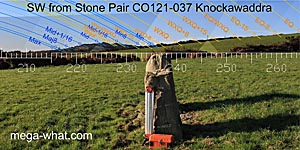 Knockawaddra Stone Pair
is the only surveyed site that has an axial alignment to the Minor Standstill. Or one quarter-month south of winter cross-quarters?
Knockawaddra Stone Pair
is the only surveyed site that has an axial alignment to the Minor Standstill. Or one quarter-month south of winter cross-quarters?
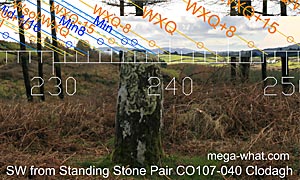 Clodagh Stone Pair
axial reverse indicates the north side of a hill. The northern basal notch marks Minor Standstill and the hilltop is a half-month south of the cross-quarters.
Clodagh Stone Pair
axial reverse indicates the north side of a hill. The northern basal notch marks Minor Standstill and the hilltop is a half-month south of the cross-quarters.
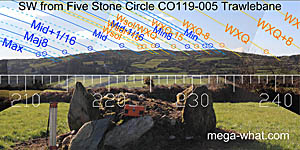 Trawlebane Stone Circle
was where I first discovered the lunar midpoint. Took me quite a while to realise what it was. The notch in the hilltop is clearly indicated by the circle's axis.
Trawlebane Stone Circle
was where I first discovered the lunar midpoint. Took me quite a while to realise what it was. The notch in the hilltop is clearly indicated by the circle's axis.
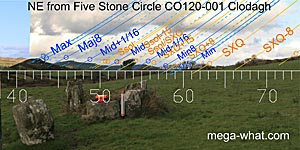 Clodagh Stone Circle
is another fine example of an indicated lunar Mid-Cycle marker. Inset is a photo of the rising moon taken 18/11/2005.
Clodagh Stone Circle
is another fine example of an indicated lunar Mid-Cycle marker. Inset is a photo of the rising moon taken 18/11/2005.
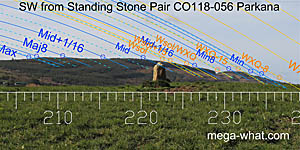 Parkana Standing Stone Pair
was clearly intended for use as an accurate sight in lieu of a natural marker. For lunar midpoint, or the Solstice?
Maybe both. Depends on vegetation cover at the time and exactly where you stand.
Parkana Standing Stone Pair
was clearly intended for use as an accurate sight in lieu of a natural marker. For lunar midpoint, or the Solstice?
Maybe both. Depends on vegetation cover at the time and exactly where you stand.
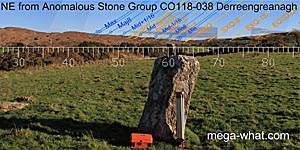 These two Standing Stones at Derreengreanagh
have their own functions as well as lining up to indicate a distant hilltop that marks the lunar minor eighth.
These two Standing Stones at Derreengreanagh
have their own functions as well as lining up to indicate a distant hilltop that marks the lunar minor eighth.
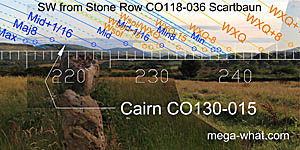 Scartbaun Stone Row points at the west side of Mt Corrin. The top is a Major Eighth and the basal dip is a Sixteenth.
Scartbaun Stone Row points at the west side of Mt Corrin. The top is a Major Eighth and the basal dip is a Sixteenth.
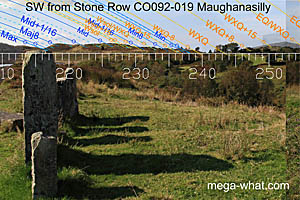 Maughanasilly Stone Row has five standing stones.
The east most three indicate Major Standstill in both directions while the western stones indicate lunar Sixteenths in both directions.
Maughanasilly Stone Row has five standing stones.
The east most three indicate Major Standstill in both directions while the western stones indicate lunar Sixteenths in both directions.
 Barrees Standing Stone Pair makes use of an unusually high horizon.
Axial reverse indicates Major Standstill. The axis is WXQ-8.
Barrees Standing Stone Pair makes use of an unusually high horizon.
Axial reverse indicates Major Standstill. The axis is WXQ-8.
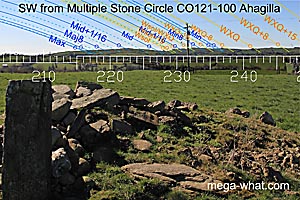 Ahagilla Stone Circle is badly damaged
but its axis clearly indicates the Major end of the lunar nodal cycle.
Ahagilla Stone Circle is badly damaged
but its axis clearly indicates the Major end of the lunar nodal cycle.
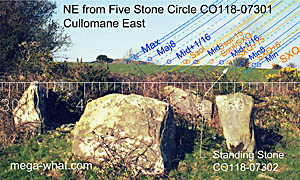 Cullomane Five Stone Circle's axial reverse indicates Major Standstill.
Drawn in black outline is the outlier's position against the sky as seen from inside the circle.
Cullomane Five Stone Circle's axial reverse indicates Major Standstill.
Drawn in black outline is the outlier's position against the sky as seen from inside the circle.
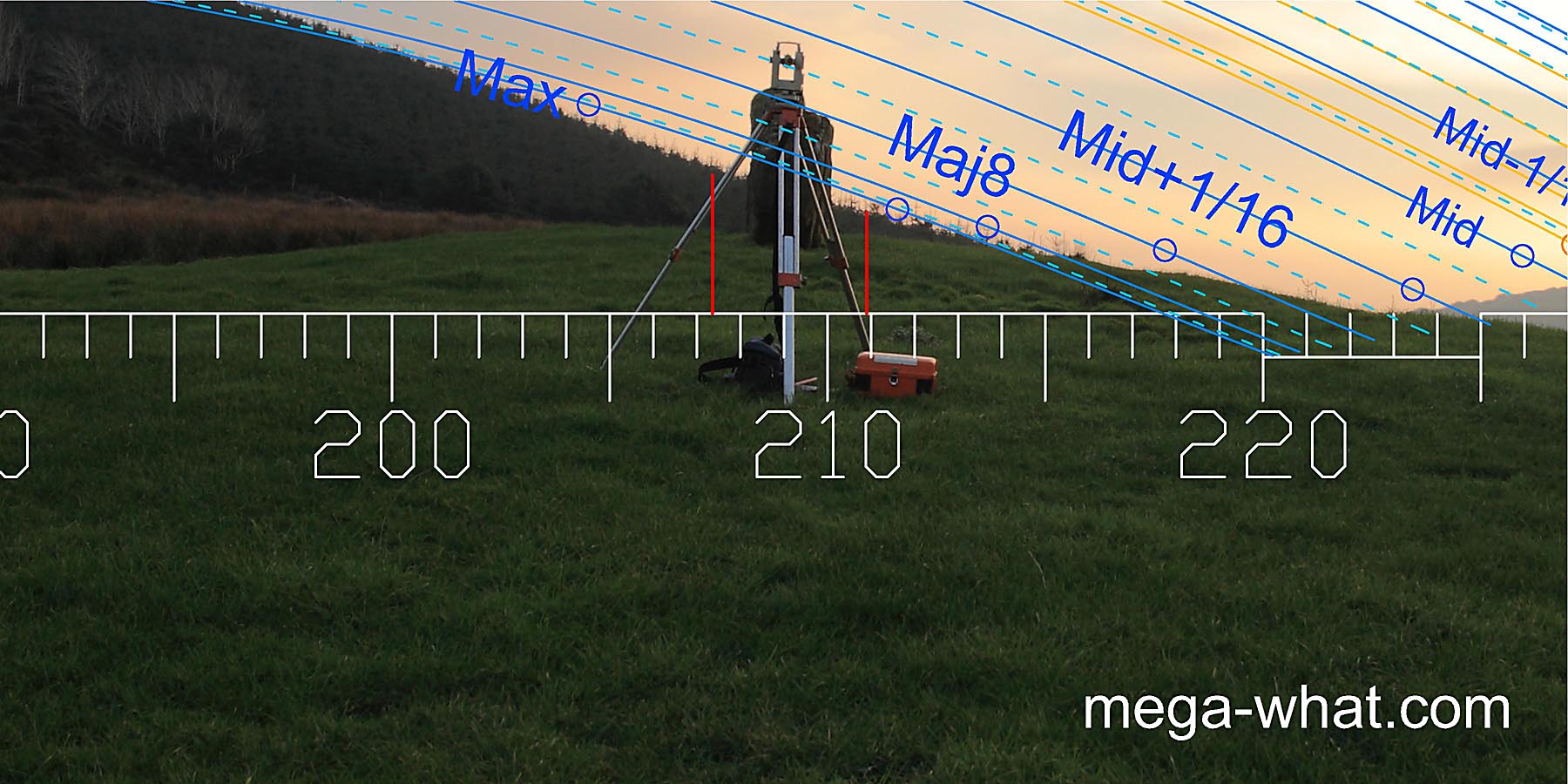 The axial alignment of Cullenagh Stone Row may be finely adjusted by walking up/down the slope towards/away from it.
The axial alignment of Cullenagh Stone Row may be finely adjusted by walking up/down the slope towards/away from it.
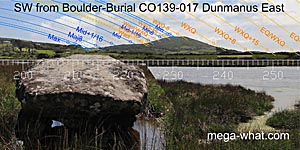 The axis of Dunmanus West Boulder-Burial indicates the Major end of the lunistice range.
The axis of Dunmanus West Boulder-Burial indicates the Major end of the lunistice range.
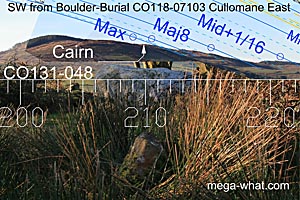 The line from this small outlier to Cullomane East Boulder-Burial indicates Major Standstill at a Cairn, now ruined.
The line from this small outlier to Cullomane East Boulder-Burial indicates Major Standstill at a Cairn, now ruined.
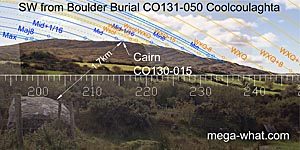 The axis of Coolcoulaghta Boulder-Burial
indicates the Major end of the lunistice range and the Cairn (rebuilt) is at the lunar midpoint.
The axis of Coolcoulaghta Boulder-Burial
indicates the Major end of the lunistice range and the Cairn (rebuilt) is at the lunar midpoint.
The Prehistoric Lunar Calendar
was developed as an attempt to explain the frequent appearance of certain declination values at significant points on the horizon.
To find these same values indicated by monument axes is confirmation of their importance but not all monuments have both a recoverable axis and unobscured horizons in the axial direction.
| Home | More Axial Alignments | Site Lists | Glossary |